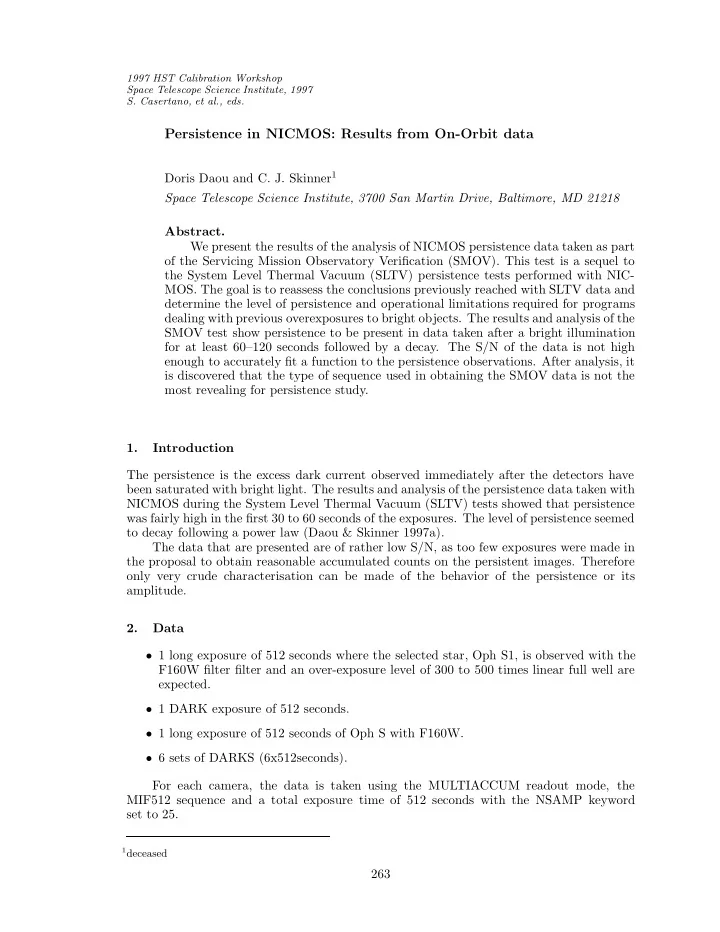

1997 HST Calibration Workshop Space Telescope Science Institute, 1997 S. Casertano, et al., eds. Persistence in NICMOS: Results from On-Orbit data Doris Daou and C. J. Skinner 1 Space Telescope Science Institute, 3700 San Martin Drive, Baltimore, MD 21218 Abstract. We present the results of the analysis of NICMOS persistence data taken as part of the Servicing Mission Observatory Verification (SMOV). This test is a sequel to the System Level Thermal Vacuum (SLTV) persistence tests performed with NIC- MOS. The goal is to reassess the conclusions previously reached with SLTV data and determine the level of persistence and operational limitations required for programs dealing with previous overexposures to bright objects. The results and analysis of the SMOV test show persistence to be present in data taken after a bright illumination for at least 60–120 seconds followed by a decay. The S/N of the data is not high enough to accurately fit a function to the persistence observations. After analysis, it is discovered that the type of sequence used in obtaining the SMOV data is not the most revealing for persistence study. 1. Introduction The persistence is the excess dark current observed immediately after the detectors have been saturated with bright light. The results and analysis of the persistence data taken with NICMOS during the System Level Thermal Vacuum (SLTV) tests showed that persistence was fairly high in the first 30 to 60 seconds of the exposures. The level of persistence seemed to decay following a power law (Daou & Skinner 1997a). The data that are presented are of rather low S/N, as too few exposures were made in the proposal to obtain reasonable accumulated counts on the persistent images. Therefore only very crude characterisation can be made of the behavior of the persistence or its amplitude. 2. Data • 1 long exposure of 512 seconds where the selected star, Oph S1, is observed with the F160W filter filter and an over-exposure level of 300 to 500 times linear full well are expected. • 1 DARK exposure of 512 seconds. • 1 long exposure of 512 seconds of Oph S with F160W. • 6 sets of DARKS (6x512seconds). For each camera, the data is taken using the MULTIACCUM readout mode, the MIF512 sequence and a total exposure time of 512 seconds with the NSAMP keyword set to 25. 1 deceased 263
264 Daou & Skinner 3. Analysis • To eliminate counts resulting from other detector-amplifier phenomena, subtract back- ground darks from the dark exposures. The background darks are synthetic darks. • To isolate the counts accumulated exclusively by each readout, subtract from each readout the previous one. • To determine the level of persistence in the illuminated area, calculate the delta- count in a box 40x50 pixels. Concentrating on this area diminishes the uncertainty introduced by other factors such as amplifier glow and pedestal effect. 4. Results Figure 1. 6 MULTIACCUM Exposures for each Camera. From Left to Right consecutively: Camera 1, Camera 2 and Camera 3. The Y-axis is the average delta count (ADU) and the X-axis is the SAMPTIME (sec). The results show the darks to have a relatively high level of counts in the area of overexposure. This symptom persists for ∼ 120 seconds. It also shows a slow decrease as a characteristic of the persistence. But although the persistence is decaying, it is still visible in all five dark exposures at a lower level of about 0.05–0.1 ADU/sec, and the persistent stellar image is still visible after 3000 seconds.
265 NICMOS Persistence Figure 2. Example of the persistent stellar image in CAMERA 1 in the first DARK exposure after a 512 seconds exposure of a bright target. These images represent different readouts from one DARK exposure at different times. From Left to right, Top to Bottom the SAMPTIMES are: 32 seconds, 128 seconds, 256 seconds, 384 seconds, 448 seconds and 512 seconds. Figure 3. Persistent stellar image is still present in the second DARK exposure in Camera 2. We can easily observe a fairly pronounced decay in the persistence signal over the first 1024 seconds. These images represent different readouts of DARK exposures at different times. From Left to right, Top to Bottom the SAMPTIMES are: 576 seconds, 704 seconds, 768 seconds, 896 seconds, 960 seconds, and 1024 seconds.
266 Daou & Skinner Figure 4. The residual persistent stellar images throughout the 5 following DARKS exposures in Camera 2. As shown in the plot, the persistent signal fol- lows a slow decay to zero. But is not totally null. These images represent different readouts of DARK exposures at different times. From Left to right, Top to Bottom the SAMPTIMES are: 1280 seconds, 1728 seconds, 2304 seconds, 2624 seconds, 2816 seconds, and 3072 seconds. 5. Conclusions We have demonstrated that persistence is fairly high in the first 60–120 seconds of an expo- sure. The persistent images are visible as long as 3000 seconds after the initial saturation on a bright source, confirming that persistence is likely to leave image artefacts during programs of observations of bright sources. Although the total counts in an exposure decreases with time since the last autoflush, the count-rate during the first read of an exposure is usually higher than that in the last read of the previous exposure, indicating that the persistence is not as simple as a steadily changing bias with time since autoflush. However, the S/N in the images obtained here is too low to accurately characterize the behavior of the persistent signal. 6. Recommendations After the analysis of the persistence in NICMOS, the Instrument Definition Team suggests that an ACCUM exposure with multiple reads after a bright object exposure, could be the solution to eliminate any persistent post-illumination light. This theory is in the process of being tested. References Daou. D. and Skinner C., 1997a, Instrument Science Report NICMOS 97-023 (Baltimore: STScI).
Recommend
More recommend